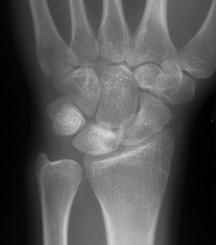
Kienbock’s Disease
Overview
Kienbock’s disease, also known as avascular necrosis of the lunate or lunate osteonecrosis, is a rare and painful medical condition that primarily affects the lunate bone in the wrist. This intricate, crescent-shaped bone is crucial for the functionality and mobility of the entire wrist. When Kienbock’s disease strikes, the blood supply to the lunate bone is compromised, leading to its eventual death or ‘necrosis.’ The disease is relatively rare, affecting approximately 1 in every 100,000 people yearly, predominantly males between the age of 20 to 40.
Types
Kienbock’s disease doesn’t have subtypes but is characterized at different stages depending on the severity of the condition. The disease is typically categorized into four stages:
-
- Stage 1: The lunate bone may appear normal, but a possible fracture or increased density may be observed.
-
- Stage 2: The lunate bone progressively hardens due to lack of blood supply.
-
- Stage 3: The bone starts to break down, leading to an irregular or ‘fragmented’ appearance.
-
- Stage 4: The disease spreads to adjacent wrist bones, leading to arthrosis (joint damage).
Causes
The exact cause of Kienbock’s disease is unknown; however, several risk factors can contribute to its development. These include:
-
- Trauma or injury to the wrist
-
- Chronic usage or exertion on the wrist
-
- Having an anatomically shorter ulna (one of the two bones in the forearm)
-
- Certain systemic diseases which impede blood flow like Lupus
Symptoms
The signs of Kienbock’s disease can vary per individual. Common symptoms include:
-
- Wrist pain that gradually worsens over time
-
- Stiffness in the affected wrist
-
- Swelling over the dorsum (back) of the wrist
-
- Gradual decrease in grip strength
Diagnosis
Diagnosis of Kienbock’s disease typically involves a combination of physical examination and imaging tests. During a physical exam, a doctor may move the wrist to check for pain and assess range of motion. Imaging tests may include x-rays, computed tomography (CT) scans, or magnetic resonance imaging (MRI). These tests can help determine the exact stage of the disease.
Treatment Options
Treatment for Kienbock’s disease depends largely on the stage of the disease and the patient’s symptoms. Options can range from non-surgical to surgical interventions.
-
- Non-surgical methods: Utilize treatments like wrist splints, physical therapy, anti-inflammatory medications, and corticosteroid injections.
-
- Surgical procedures: These can involve revascularization (restoring the blood supply), joint leveling, or in advanced stages, partial or complete wrist fusion.
Living With Kienbock’s Disease
Living with Kienbock’s disease can be challenging, but certain strategies can significantly enhance quality of life:
-
- Management of pain: Over-the-counter (OTC) medications or prescribed analgesics may help manage pain.
-
- Regular check-ups: Regular appointments with a healthcare provider can monitor disease progression and adjust treatment plans.
-
- Lifestyle modifications: Avoiding strenuous wrist activities and using assistive devices can reduce strain on the wrist.
When to Seek Help
People should seek immediate medical help if they experience persistent wrist pain, difficulty in moving the wrist, or wrist swelling. Early diagnosis and treatment can significantly help reduce the impact of Kienbock’s disease on a person’s daily activities and quality of life.
